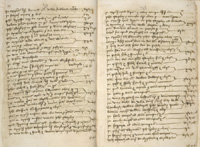 |
 |
 |
 |
 |
 |
 |
|
Fountains Abbey: History
Fountains Abbey: Buildings
|
Sources (1/2) A rich and wide-ranging body of surviving evidence sheds considerable light on the lives of the monks and lay-brothers who belonged to Fountains during the Middle Ages. Written documents include charters granting (or confirming) lands and rights to the community,(2) letters, royal privileges and papal bulls. A history of the abbey from its foundation to c.1220 is recorded in the Narratio de fundatione Fontanis monasterii, the foundation history of the abbey.(3) Interesting and important sources for the later history of Fountains are the ‘President’s Book’, the ‘Bursar’s book’ and the ‘Memorandum Book of Thomas Swinton’. These were compiled during the abbacy of John Greenwell 1442-71.(4) The ‘President’s Book’ chronicles the abbots of Fountains from its foundation until Greenwell’s abbacy, although the earlier material is taken from the Narratio. The ‘Bursar’s Book’ is a neatly-written record of Abbot John’s household expenses from 1456 to 1459, but is much more than a collection of facts and figures. The book provides a wealth of information regarding the daily life and administration of the monastery and of the abbot’s household. It reveals, for example, that in 1457 the abbot travelled to two of Fountains’ daughter-houses, Meaux and Woburn, for the installation of its abbots, and that payments were made to men who directed the party through unfamiliar territory. We learn that the abbot received a gift of ‘sealfish’ from the prior of Newminster, that deerskin was bought for his boots, and that he served calves, faggots and figs at his table. The ‘Bursar’s Book’ records all purchases made by the community, from felt hats and bell-strings, to urinals and a pair of clavichords. Unfortunately, the book has suffered over the years from dampness and mice, but still retains its vellum cover. It now forms Leeds City Archives VR 5497; a printed edition is available in Memorials of Fountains III. An insight to the financial administration of the abbey is provided by the 'Memorandum Book' of Thomas Swinton, 1446-58’. Swinton was at this time an important office–holder of Fountains, although it is not certain which office he held; he presided as abbot of Fountains from 1471-1478. The ‘Memorandum Book’ is a small, rather untidy book of accounts and is now preserved in the British Library. It includes information regarding the wages paid to servants and tenants of the abbey and of rents received, of debts owing to the abbey and purchases made. It also reveals details relating to Swinton’s business trips, such as his expenses and transactions, and offers a wealth of unusual information relating to Fountains at this time. For example, there are details about the abbey’s sales of manure and hides, of purchases of livestock and gloves, and of the help of women at harvest. We learn that when Swinton was at York on All Saints Day, he and his companions dined on goose, but during Lent they kept the fast and ate fish, sometimes with mustard and salt, and perhaps also figs and raisins. |

